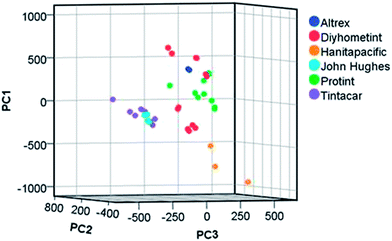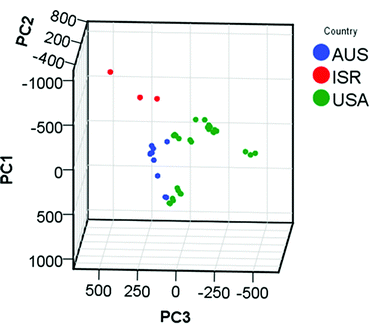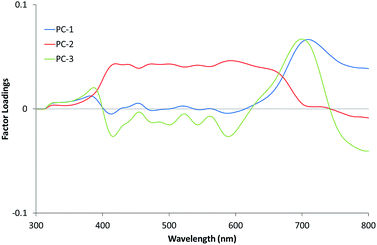 Open Access Article
Open Access ArticleUltraviolet-visible spectroscopic characterisation of automotive window tints for forensic purposes†
Karin J.
van der Pal
ab,
Mark
Maric‡
ab,
Wilhelm
van Bronswijk
b and
Simon W.
Lewis
*ab
aNanochemistry Research Institute, GPO Box U1987, Perth, Western Australia 6845, Australia. E-mail: S.Lewis@curtin.edu.au; Tel: +61 8 9266 2484
bDepartment of Chemistry, Curtin University, GPO Box U1987, Perth, Western Australia 6845, Australia
First published on 8th June 2015
Abstract
Automotive window tint samples sourced from Western Australian retailers were analysed using transmission ultraviolet-visible spectroscopy. The spectra showed features characteristic of known window tint film components such as polyethylene terephthalate and cyclic imino esters. Principal component analysis showed that samples cluster by both groups of supplier and individual samples, indicating good reproducibility and sample separation. Window tint samples could be traced back to one of three countries of manufacture, Australia, USA and Israel, suggesting that different suppliers are sourcing their samples from the same manufacturer. This indicates the potential for window tint to be used as forensic evidence, as samples are able to be compared on a questioned versus known basis due to the variation in the sources.
Introduction
Due to the prevalence of polymers in everyday products, polymeric trace evidence is an important aspect of forensic science in respect to its ability to provide associations between people, objects and places; and this is no exception in regards to crime involving motor vehicles.1–4 One form of potential trace evidence from such incidents is automotive window tint. This is a coating designed to reduce the glare from the sun to the observer within the vehicle and to protect the interior of cars from sun damage.5 It is also advertised to reduce the shattering of glass on impact.6Window tint has been reported to have been found on evidential glass fragments; however there are no standard or recommended methods for its analysis for forensic purposes.7 The analysis of window tint could potentially be beneficial for the comparison of questioned versus known glass samples or to classify and individualise an unknown sample to identify the type of vehicle that the tint may have come from. However, to date there has been a lack of research into this form of evidence, which is required to assess the potential of window tint as evidence.8
Window tint was not widely available to the public in Western Australia until the early 1990s, when window tint film became legalised in this jurisdiction. Window tint is composed of a polyester film which may also be combined with cyclic imino esters that act as chemical ultraviolet (UV) blockers and filter out UV radiation.9 On one side of the film, a pressure or water sensitive adhesive is applied to allow the tint to stick to the glass surface, and on the other side a scratch proof coating is applied to extend the lifetime of the film.6,9 This protects the glass underneath and adds shatter resistance. Window tints are available in various grades based on the amount of visible light that is transmitted by the film, e.g. a 5% tint filters out 95% of visible light passing through the glass.10 There are three main categories of window tint available on the market: dyed, metallised and ceramic; as well as hybrid combinations of the three.
Dyed window tint consists of a clear polyethylene terephthalate (PET) film that has been left in a dye bath for a period of time to achieve the desired tint intensity.5,11,12 The dyed film absorbs some of the infrared and visible radiation from the sun to keep a car cool. This style of tint was the first type of tint available to the market.9
Metallised tints work on the principle of reflecting light rather than absorbing it. Metallised tint film is produced in two ways, either with a deposition or a sputter process.5 The deposition process involves drawing the tint through a metal ingot bath and inducing a vacuum in the tank. Argon gas is then flooded into the tank under heat, forcing some of the metal (aluminium, nickel–chrome alloy or copper) to be drawn to the surface of the tint.5,6,9 The sputter process is also performed under vacuum; however, it is done by creating ions which are forced towards the metal by electromagnetic fields. The ions, on collision with the metal, cause small groups of the metal to dislodge and scatter across the film.5 Hybrid films are a combination of the dyed and metallised films allowing both heat absorption and reflection.9,12 The deposition process is used to produce a highly reflective mirror styled tint, and the sputter process to produce hybrid film.13
Ceramic or crystalline tinting is a new variant on the hybrid style of film. It consists of a fine mist of ceramic components sprayed across a polymer film and then sandwiched with a dyed layer.11,13 Crystalline tinting allows a reduced colour intensity in the tint and higher clarity compared to metallised tints.13
The potential for window tint to be used as forensic evidence is dependent upon the ability to characterise and group different tints through physical and chemical analysis. Such characterisation may derive from the different dyes which are used to give the tint colour, metals applied for reflectivity and polymers utilised in the production of the tint. Window tint manufacturers use a variable light source and a detector to determine the light frequencies that are blocked by a tint, to generate a grade (% transmission) to indicate the amount of visible light blocked.5,6,12 Transmission ultraviolet visible (UV-vis) spectroscopy, which operates on a similar principle, may therefore be an ideal approach to characterising the colour and transparency of window tint.
One of the issues with many forensic comparisons is the lack of objectivity.2,8 Chemometrics is the process of extracting statistical information and relationships from chemical multivariate data.14,15 It uses well-documented statistical techniques to model variance in the data and can potentially identify group characteristics and allow predictions to be made.16–18 The advantage of using chemometrics over visual comparison for forensic purposes is that bias and human error are reduced.17–19
The National Academy of Science report of 2009 called for a better understanding of the fundamental science behind types of evidence, particularly when exploring a diverse but limited population of samples.8 This paper presents data from a preliminary study into the diversity of automotive window tint films commonly used in Western Australia, using ultraviolet visible spectroscopy in combination with chemometrics.
Materials and methods
Sample collection and preparation
Window tint samples were donated by local tint application companies and further samples purchased online (ESI Table S1†). Each tint sample was cut to a 5 × 8 cm rectangle with a Fellowes SafeCut Rotary Trimmer and stored in a labelled plastic clip seal bag.Ultraviolet visible spectroscopy
Window tint spectra were obtained using an Agilent Cary Series 4000 UV-vis spectrophotometer. The internal sample holders were removed from the sample compartment of the instrument and a standard infrared slide sample holder was placed at a 45° angle to the incident beam. Angling the sample from normal to the incident beam reduces or eliminates the interference fringes arising from reflections for the two film surfaces. Scans were collected over a range of 200–900 nm at an interval of 0.5 nm. Data acquisition was performed with Cary WinUV software v4.1. Six sample replicates were collected by repositioning the sample in a vertical motion on the sample holder. A blank air scan was executed between each sample.Data analysis
Principal component analysis was performed using the Unscrambler X software v10.3 (Camo Software AS, Oslo, Norway). Tint spectra were baseline corrected to zero percent transmission to account for any minor offsets (<0.001%), and truncated to 300–800 nm as no peaks were observed outside of this region. Spectra were not normalised, as this would have altered the absolute differences in transmission which are a primary tint variable.Results and discussion
Window tint samples were analysed using transmission UV-vis spectroscopy to determine the properties that may allow tints to be characterised and used as forensic evidence. Only non-metallised samples were able to be measured with UV-vis spectroscopy. Metallised samples caused scattering of the incident light, creating an apparent absorbance of the incident beam as less light reached the detector. The spectra of these metallised samples also manifested a reflectance/interference sine wave.Inspection of the spectra shows obvious differences in the spectra between both the brands and transmission grades of the tested tints (Fig. 1a and b). The spectra in Fig. 1a show samples do not transmit UV wavelengths shorter then ∼350 nm. The complete absence of transmitted light below 300 nm is characteristic of the PET polymer used in the film, which was confirmed by obtaining a reference scan of PET. The cut-off at ∼400 nm and the band at ∼700 nm are characteristic of cyclic imino esters which are used to reduce the amount of UV light able to penetrate the film.20–22 Light transmission in the visible region is reduced to less than 50%, most likely due to the dyes incorporated during the manufacturing process.
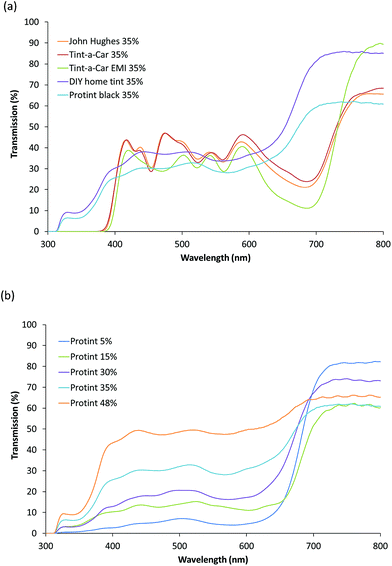 | ||
| Fig. 1 (a) Transmission spectra of various brands of 35% transmission grade tint. (b) Transmission spectra of Protint with different grades of transmission. | ||
From the variation in transmission for the different grades in a single brand of tint obtained in Western Australia, shown in Fig. 1b, it is evident that the materials used the manufacturing process remain the same. However, the concentration of the colourants and dyes present are increased as the transmission grade is decreased, as expected from the Beer–Lambert law.
In order to assess the potential of window tint samples available in Western Australia for forensic trace evidence purposes, principal component analysis (PCA) was employed to objectively characterise the variation in their spectra. PCA is a chemometric technique that uses linear combinations of the original variables to produce new orthogonal variables (principal components) to describe the variance in multivariate data.14,18 The number of required principal components (PCs) to retain most of the information is much less than the number of original variables, and this may be used to elucidate potential relationships between samples that would not be readily obvious otherwise.17,23
PCA of the entire dataset (234 spectra) showed that 97.0% of the total variance was accounted for in the first three PCs (ESI Fig. S1†). It would be anticipated that PCs 4–7 would not describe any significant differences between the tints due to the small variance they account for in total. Hence the first three PCs were used to generate a 3-dimensional scores plot for visualising the variance in the dataset (Fig. 2). The six replicate spectra collected for each particular sample are not distinguishable in Fig. 3, indicating that the intra-sample variation is negligible compared to the inter-sample variation. This shows that the method has good reproducibility.
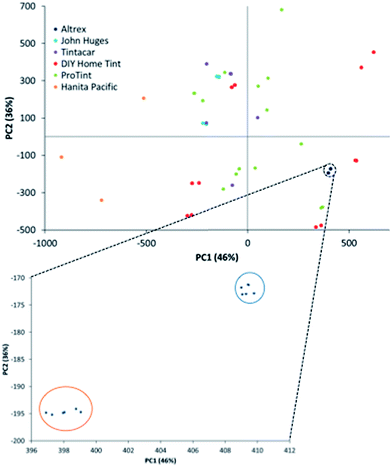 | ||
| Fig. 3 Expanded region of 2D scores plot of the window tint data set for Altrex sample showing roll separation. | ||
It should also be noted that an individual sample's replicate scores (e.g. Altrex) were dependent on the roll from which the sample was collected (Fig. 3). This indicates that window tint manufacturing is not consistent over time, with the possibility that concentrations of chemicals as well as slight changes in the layer thickness may occur. This suggests that the characterisation and discrimination of window tint evidence by UV-vis transmission spectroscopy is possible and that PCA is a suitable strategy for questioned versus known comparisons. In instances where only a questioned sample is available, this may also enable investigators to reduce the scope of their enquiries by employing the use of a supervised chemometric technique such as linear discriminant analysis (LDA).17,19 LDA develops a predictive model utilising a mutually exclusive test set and validation set. A test set is used to build the model, which is then used to predict classifications for the validation set.16,23
In addition to the clustering occurring within each sample, some grouping appears to occur with samples of different brands such as John Hughes and Tint-a-Car. These samples are clearly grouped together and it is suspected that there are suppliers selling tints by the same manufacturer in the sample set. It was not possible to ascertain the specific supplier of the tints as most window tinting companies were unwilling to supply this information. However, it was stated by John Hughes and Tint-a-car that both their films were manufactured in the USA, thus supporting the conclusion that the samples for these companies are possibly made by the same supplier.
The tint samples in the 3D PCA model were coded by country of manufacturer and, as shown in Fig. 4, generalised groupings occur. This further supports the conclusion that different suppliers may be selling similar window tints provided by the same manufacturer. This, while not currently a useful detail for forensic investigations, indicates that there are promising data correlations forming within the model.
In order to determine what causes the PCA separation between different tints, the factor loadings were investigated as shown in Fig. 5. The loading factor maxima and minima indicate regions where the spectral data has a high influence on the separation. PCs 1 and 3 appear to be affected the most by the presence of a peak location around 700 nm in the near IR region; this peak correlates with a peak that is characteristic of cyclic imino esters as previously mentioned. The slight peak shifts are most likely caused by the use of different imino esters by various companies. PC2 is affected more by the wavelengths in the visible region caused by variations in the dyes, and thus separation along this PC appears to be on the basis of the transmission grades.
Conclusions
Analysis of window tint with UV-vis transmission spectroscopy showed that dyed window tints can be successfully characterised based on the spectra obtained. The spectra show differences between films that are characteristic of the PET plastic film used as well as the cyclic imino esters present. The use of chemometrics in conjunction with UV-vis spectroscopy, for 24 samples, shows that samples are well defined and group in clusters relating to the country of manufacture (Australia, Israel and USA).To continue with this line of research, the next step would be to expand the library of samples used and create a new model with the additional samples. These new samples should be sourced from areas around the world so that the model is not just applicable to Western Australia. Development of methods of analysis for samples that are metallised would be advantageous, as these samples make up a large proportion of the films sold by the tinting sector. Further investigations should also be made into methods of analysis for real world tint samples, as samples collected at crime scene are usually small and attached to pieces of glass. This would involve studying the effects that a physical impact and weathering may have on the tint.
Acknowledgements
The authors thank Peter Chapman (Curtin University) for providing technical assistance with visible spectroscopy and Dr Kari Pitts (ChemCentre) for useful discussions concerning the forensic potential of automotive window tint. Additionally, the authors would also like to recognise Tint-A-Car, Myaree and Novus Autoglass, Malaga for their donations of window tint. Portions of this work were presented in the inaugural RSC Analytical Science Twitter Poster Conference (5th Feb. 2015) as well as at the ANZFSS 22nd International Symposium on the Forensic Sciences (Adelaide, 2014).References
- P. White, Crime scene to court: the essentials of forensic science, Royal society of chemistry, 2010 Search PubMed.
- M. M. Houck and J. A. Siegel, Fundamentals of Forensic Science, 2nd edn, Elsevier Academic Press, China, 2010 Search PubMed.
- V. Causin, Polymers on the crime scene: How can analytical chemistry help to exploit the information from these mute witnesses?, Anal. Methods, 2010, 2(7), 792–804 RSC.
- V. Causin, Polymeric Traces: Transfer, Persistence, Recovery, Analysis and Interpretation of Analytical Data, in Polymers on the Crime Scene, Springer, 2015, pp. 53–103 Search PubMed.
- LLumar, How does automotive window film work?, 2014, http://www.llumar.com/ Search PubMed.
- Tint Industry, All About Window Tinting Films, updated 2013, http://www.tintindustry.com/ Search PubMed.
- K. Pitts, Forensic scientist, ChemCentre, Personal Communication, 2014.
- National Academy of Sciences, Strengthening forensic science in the United States: a path forward, National Research Council, Washington DC, 2009, Committee on Identifying the Needs of the Forensic Sciences Community Search PubMed.
- Tinting Australia, How does Window Tint Film work?, 2010 cited 2/07/14, http://www.tintingaustralia.com.au/ Search PubMed.
- M. G. Kimlin and A. V. Parisi, Ultraviolet radiation penetrating vehicle glass: A field based comparative study, Phys. Med. Biol., 1999, 44(4), 917 CrossRef CAS.
- Independant Tinting Network, Window Film Simulator Automotive, 2014, http://www.windowtint.com.au/.
- Global Window Films, SEMA show 2011-Global window Film – How it's Made, 2011.
- OzTint, Types of Automotive Tint, 2014, http://www.oztint.com.au/types.php.
- R. G. Brereton, Chemometrics: data analysis for the laboratory and chemical plant, John Wiley & Sons, 2003 Search PubMed.
- A. N. Mendlein, J. A. Siegel and J. V. Goodpaster, Instrumental and chemometric analysis of automotive clear coat paints by micro laser Raman, American Chemical Society, Indianapolis (United States), 2011, 42nd Central Regional Meeting of the American Chemical Society, Jun 8–10 Search PubMed.
- R. G. Brereton. Pattern recognition, in Applied Chemometrics for Scientists, John Wiley & Sons, 2007, pp. 145–191 Search PubMed.
- J. N. Miller and J. C. Miller, Statistics and chemometrics for analytical chemistry, Pearson Education, 2005 Search PubMed.
- M. Otto, Chemometrics: statistics and computer application in analytical chemistry, Wiley-VCH, New York, 1999 Search PubMed.
- K. Varmuza and P. Filzmoser, Introduction to Multivariate Statistical Analysis in Chemometrics, Taylor & Francis, Boca Raton, FL, 2009 Search PubMed.
- T. Oya, Near infrared ray shielding film, Google Patents, 2003, WO 2003000779 A1.
- T. Oya, M. Fukuda and M. Handa, Biaxially oriented polyester film, adhesive film and colored hard coating film, Google Patents, 2003, WO 2003074272 A1.
- R. A. Tennant and T. G. Hood, Lighting fixture reflector containing ultraviolet absorber, Google Patents, 1993, US 5251064A.
- M. J. Adams, Chemometrics in analytical spectroscopy, Royal Society of Chemistry, 2004 Search PubMed.
Footnotes |
| † Electronic supplementary information (ESI) available: Window tints used in study, Variance plot for PCA. See DOI: 10.1039/c5ay01381j |
| ‡ Current address: National Centre of Forensic Science, University of Central Florida, PO Box 162367, Orlando, Florida USA 32816 |
| This journal is © The Royal Society of Chemistry 2015 |

